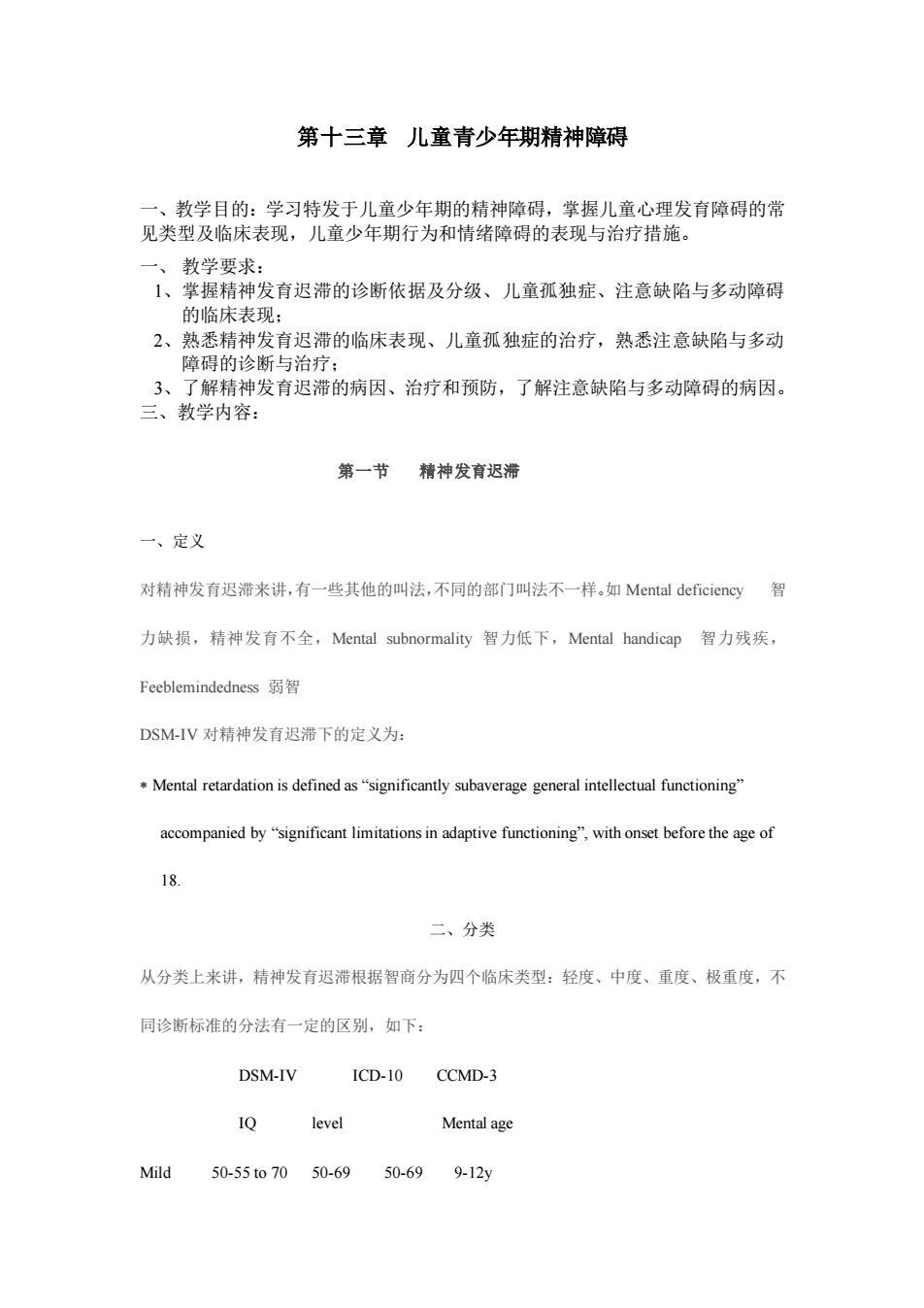
第十三章儿童青少年期精神障碍教学目的:学习特发于儿童少年期的精神障碍,掌握儿童心理发育障碍的常见类型及临床表现,儿童少年期行为和情绪障碍的表现与治疗措施。一、教学要求:1、掌握精神发育迟滞的诊断依据及分级、儿童孤独症、注意缺陷与多动障碍的临床表现;2、熟悉精神发育迟滞的临床表现、儿童孤独症的治疗,熟悉注意缺陷与多动障碍的诊断与治疗;3、了解精神发育迟滞的病因、治疗和预防,了解注意缺陷与多动障碍的病因。三、教学内容:第一节精神发育迟滞一、定义对精神发育迟滞来讲,有一些其他的叫法,不同的部门叫法不一样。如Mentaldeficiency智力缺损,精神发育不全,Mental subnormality智力低下,Mentalhandicap智力残疾,Feeblemindedness弱智DSM-IV对精神发育迟滞下的定义为:* Mental retardation is defined as “significantly subaverage general intellectual functioning”accompanied by“significant limitations in adaptive functioning"with onset before the age of18.二、分类从分类上来讲,精神发育迟滞根据智商分为四个临床类型:轻度、中度、重度、极重度,不同诊断标准的分法有一定的区别,如下:DSM-IVICD-10CCMD-3IQlevelMental ageMild50-55 to 7050-6950-699-12y
第十三章 儿童青少年期精神障碍 一、教学目的:学习特发于儿童少年期的精神障碍,掌握儿童心理发育障碍的常 见类型及临床表现,儿童少年期行为和情绪障碍的表现与治疗措施。 一、 教学要求: 1、掌握精神发育迟滞的诊断依据及分级、儿童孤独症、注意缺陷与多动障碍 的临床表现; 2、熟悉精神发育迟滞的临床表现、儿童孤独症的治疗,熟悉注意缺陷与多动 障碍的诊断与治疗; 3、了解精神发育迟滞的病因、治疗和预防,了解注意缺陷与多动障碍的病因。 三、教学内容: 第一节 精神发育迟滞 一、定义 对精神发育迟滞来讲,有一些其他的叫法,不同的部门叫法不一样。如 Mental deficiency 智 力缺损,精神发育不全,Mental subnormality 智力低下,Mental handicap 智力残疾, Feeblemindedness 弱智 DSM-IV 对精神发育迟滞下的定义为: Mental retardation is defined as “significantly subaverage general intellectual functioning” accompanied by “significant limitations in adaptive functioning”, with onset before the age of 18. 二、分类 从分类上来讲,精神发育迟滞根据智商分为四个临床类型:轻度、中度、重度、极重度,不 同诊断标准的分法有一定的区别,如下: DSM-IV ICD-10 CCMD-3 IQ level Mental age Mild 50-55 to 70 50-69 50-69 9-12y
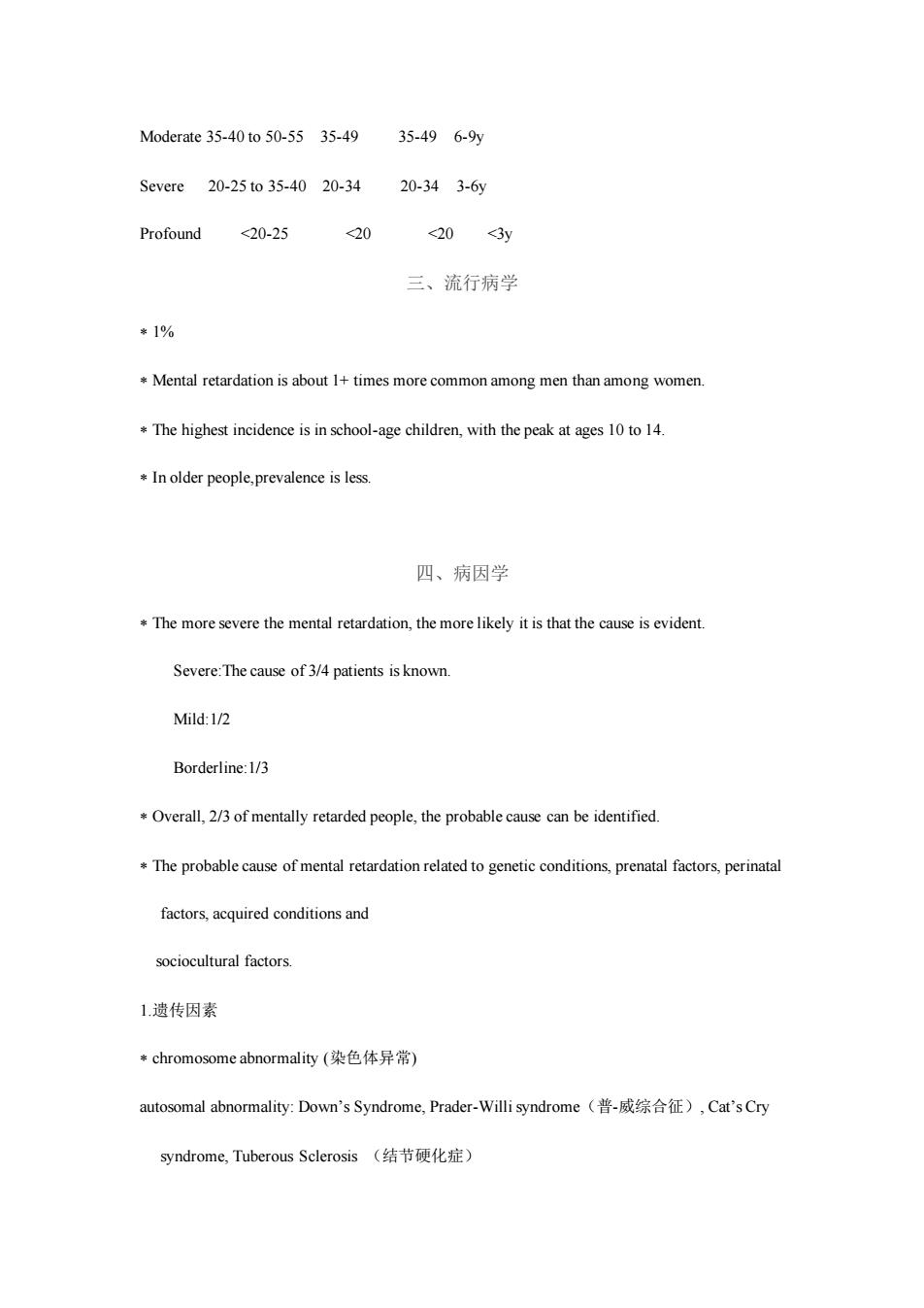
Moderate 35-40 to 50-5535-4935-496-9y20-34Severe20-25to35-4020-343-6y<20-25<20<20<3yProfound三、流行病学* 1%*Mental retardation isabout I+times more common amongmen thanamong women.* The highest incidence is in school-age children, with the peak at ages 10 to 14* In older people,prevalence is less.四、病因学* The more severe the mental retardation, the more likely it is that the cause is evident.Severe:Thecauseof3/4patients isknownMild:1/2Borderline:1/3*Overall,2/3ofmentallyretardedpeople,theprobablecausecanbe identified* The probable cause of mental retardation related to genetic conditions, prenatal factors, perinatalfactors, acquired conditions andsocioculturalfactors.1.遗传因素*chromosomeabnormality(染色体异常)autosomal abnormality:Down'sSyndrome,Prader-Willi syndrome(普-威综合征),CatsCry(结节硬化症)syndrome, Tuberous Sclerosis
Moderate 35-40 to 50-55 35-49 35-49 6-9y Severe 20-25 to 35-40 20-34 20-34 3-6y Profound <20-25 <20 <20 <3y 三、流行病学 1% Mental retardation is about 1+ times more common among men than among women. The highest incidence is in school-age children, with the peak at ages 10 to 14. In older people,prevalence is less. 四、病因学 The more severe the mental retardation, the more likely it is that the cause is evident. Severe:The cause of 3/4 patients is known. Mild:1/2 Borderline:1/3 Overall, 2/3 of mentally retarded people, the probable cause can be identified. The probable cause of mental retardation related to genetic conditions, prenatal factors, perinatal factors, acquired conditions and sociocultural factors. 1.遗传因素 chromosome abnormality (染色体异常) autosomal abnormality: Down’s Syndrome, Prader-Willi syndrome(普-威综合征), Cat’s Cry syndrome, Tuberous Sclerosis (结节硬化症)
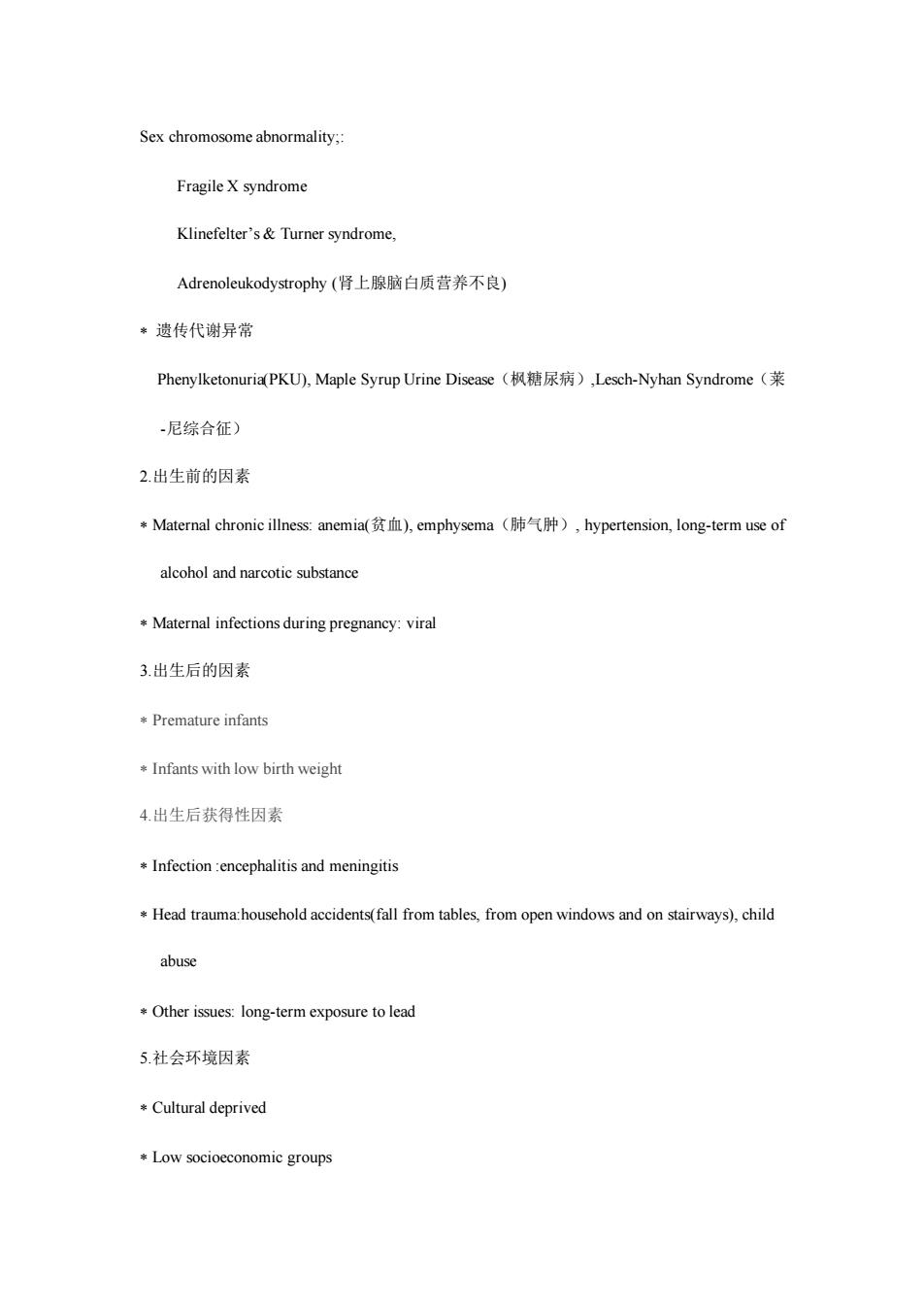
Sex chromosomeabnormality;:FragileX syndromeKlinefelter's& Turner syndrome,Adrenoleukodystrophy(肾上腺脑白质营养不良)*遗传代谢异常Phenylketonuria(PKU),MapleSyrupUrineDisease(枫糖尿病),Lesch-NyhanSyndrome(莱-尼综合征)2.出生前的因素*Maternal chronic illness:anemia(贫血),emphysema(肺气肿),hypertension,long-term useofalcoholandnarcoticsubstance* Maternal infections during pregnancy: viral3.出生后的因素*Premature infants*Infants with low birth weight4.出生后获得性因素* Infection :encephalitis and meningitis*Head trauma:householdaccidents(fall fromtables, from open windows and on stairways),childabuse*Otherissues:long-term exposuretolead5.社会环境因素* Cultural deprived*Lowsocioeconomicgroups
Sex chromosome abnormality;: Fragile X syndrome Klinefelter’s & Turner syndrome, Adrenoleukodystrophy (肾上腺脑白质营养不良) 遗传代谢异常 Phenylketonuria(PKU), Maple Syrup Urine Disease(枫糖尿病),Lesch-Nyhan Syndrome(莱 -尼综合征) 2.出生前的因素 Maternal chronic illness: anemia(贫血), emphysema(肺气肿), hypertension, long-term use of alcohol and narcotic substance Maternal infections during pregnancy: viral 3.出生后的因素 Premature infants Infants with low birth weight 4.出生后获得性因素 Infection :encephalitis and meningitis Head trauma:household accidents(fall from tables, from open windows and on stairways), child abuse Other issues: long-term exposure to lead 5.社会环境因素 Cultural deprived Low socioeconomic groups
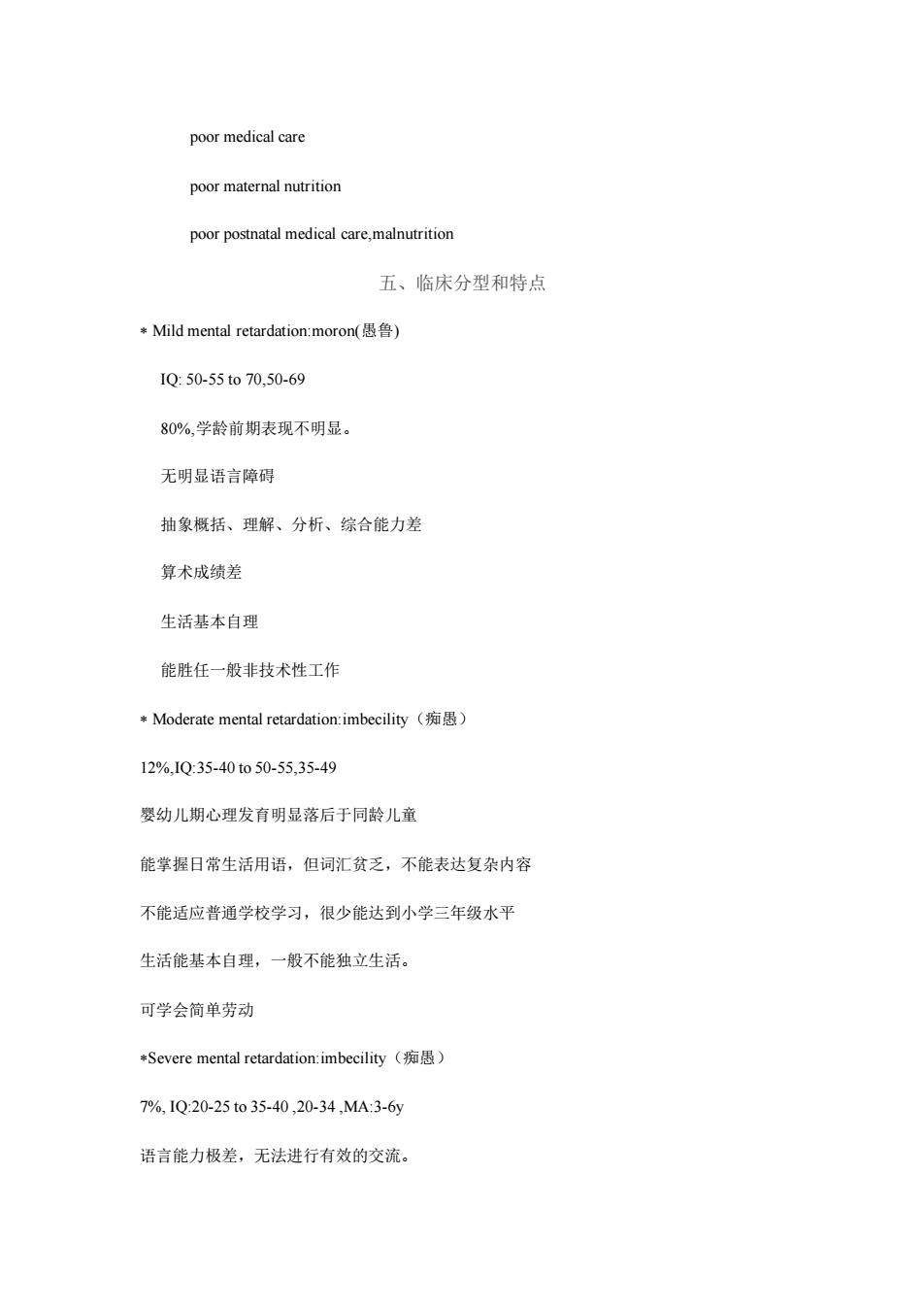
poor medical carepoormaternalnutritionpoor postnatal medical care,malnutrition五、临床分型和特点*Mildmentalretardation:moron(愚鲁)IQ: 50-55 to 70,50-6980%,学龄前期表现不明显。无明显语言障碍抽象概括、理解、分析、综合能力差算术成绩差生活基本自理能胜任一般非技术性工作*Moderatementalretardation:imbecility(痴愚)12%,IQ:35-40 to50-55,35-49婴幼儿期心理发育明显落后于同龄儿童能掌握日常生活用语,但词汇贫乏,不能表达复杂内容不能适应普通学校学习,很少能达到小学三年级水平生活能基本自理,一般不能独立生活。可学会简单劳动+Severemental retardation:imbecility(痴愚)7%, IQ:20-25 to 35-40,20-34,MA:3-6y语言能力极差,无法进行有效的交流
poor medical care poor maternal nutrition poor postnatal medical care,malnutrition 五、临床分型和特点 Mild mental retardation:moron(愚鲁) IQ: 50-55 to 70,50-69 80%,学龄前期表现不明显。 无明显语言障碍 抽象概括、理解、分析、综合能力差 算术成绩差 生活基本自理 能胜任一般非技术性工作 Moderate mental retardation:imbecility(痴愚) 12%,IQ:35-40 to 50-55,35-49 婴幼儿期心理发育明显落后于同龄儿童 能掌握日常生活用语,但词汇贫乏,不能表达复杂内容 不能适应普通学校学习,很少能达到小学三年级水平 生活能基本自理,一般不能独立生活。 可学会简单劳动 Severe mental retardation:imbecility(痴愚) 7%, IQ:20-25 to 35-40 ,20-34 ,MA:3-6y 语言能力极差,无法进行有效的交流
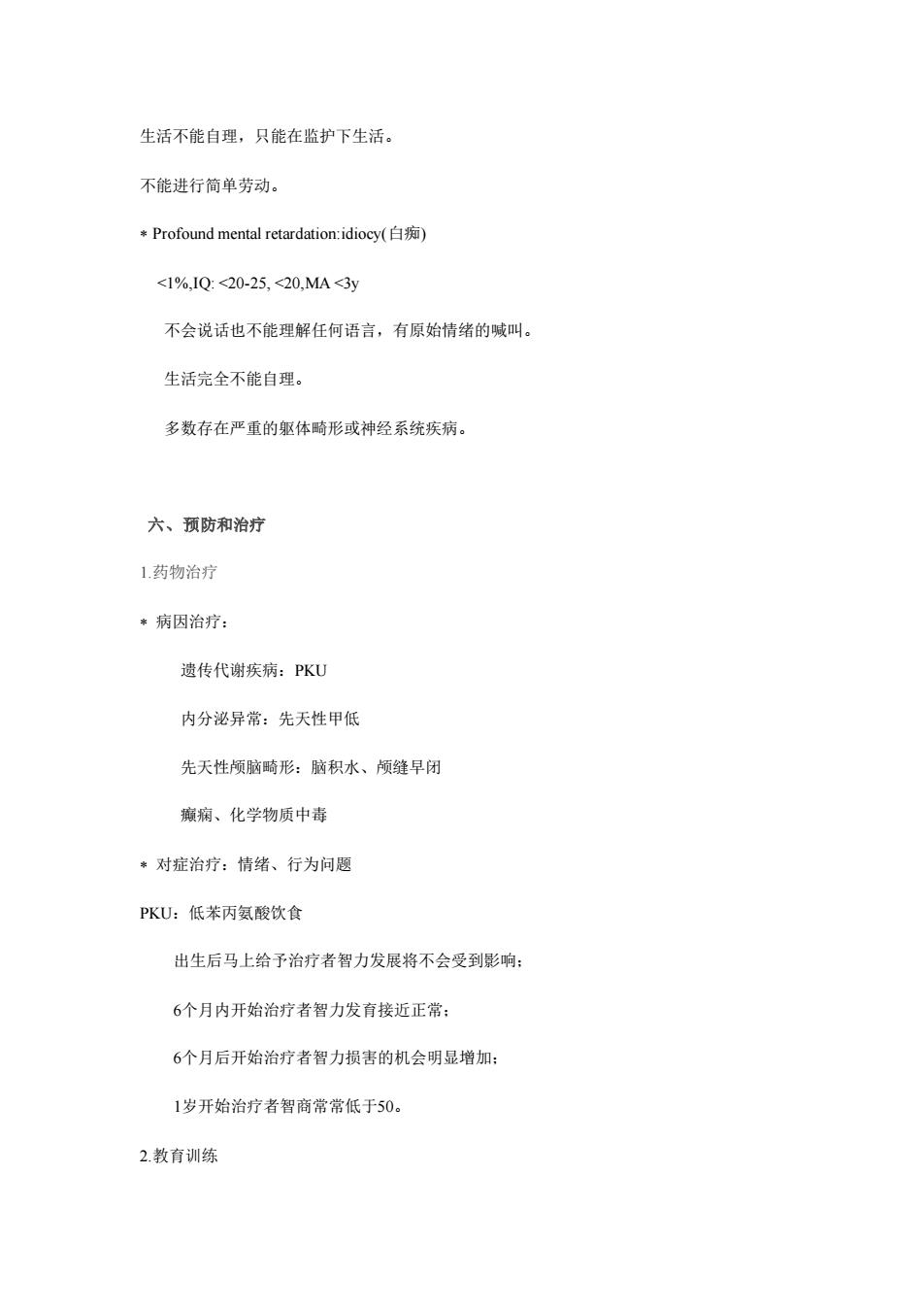
生活不能自理,只能在监护下生活。不能进行简单劳动。*Profoundmentalretardation:idiocy(白痴)<1%,IQ:<20-25,<20,MA<3y不会说话也不能理解任何语言,有原始情绪的喊叫。生活完全不能自理。多数存在严重的躯体畸形或神经系统疾病六、预防和治疗1.药物治疗*病因治疗:遗传代谢疾病:PKU内分泌异常:先天性甲低先天性颅脑畸形:脑积水、颅缝早闭癫痫、化学物质中毒*对症治疗:情绪、行为问题PKU:低苯丙氨酸饮食出生后马上给予治疗者智力发展将不会受到影响;6个月内开始治疗者智力发育接近正常;6个月后开始治疗者智力损害的机会明显增加:1岁开始治疗者智商常常低于50。2.教育训练
生活不能自理,只能在监护下生活。 不能进行简单劳动。 Profound mental retardation:idiocy(白痴) <1%,IQ: <20-25, <20,MA <3y 不会说话也不能理解任何语言,有原始情绪的喊叫。 生活完全不能自理。 多数存在严重的躯体畸形或神经系统疾病。 六、预防和治疗 1.药物治疗 病因治疗: 遗传代谢疾病:PKU 内分泌异常:先天性甲低 先天性颅脑畸形:脑积水、颅缝早闭 癫痫、化学物质中毒 对症治疗:情绪、行为问题 PKU:低苯丙氨酸饮食 出生后马上给予治疗者智力发展将不会受到影响; 6个月内开始治疗者智力发育接近正常; 6个月后开始治疗者智力损害的机会明显增加; 1岁开始治疗者智商常常低于50。 2.教育训练